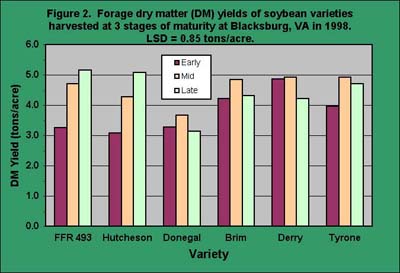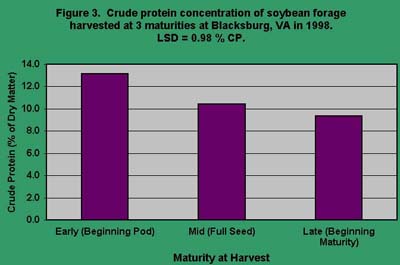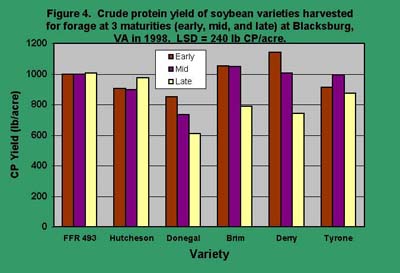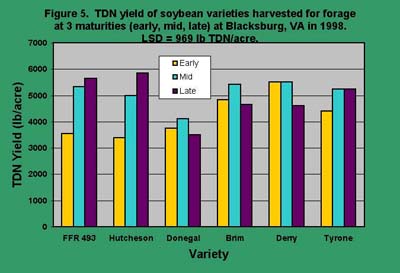
You've reached the Virginia Cooperative Extension Newsletter Archive. These files cover more than ten years of newsletters posted on our old website (through April/May 2009), and are provided for historical purposes only. As such, they may contain out-of-date references and broken links.
To see our latest newsletters and current information, visit our website at http://www.ext.vt.edu/news/.
Newsletter Archive index: http://sites.ext.vt.edu/newsletter-archive/

Soybeans for Forage
Crop and Soil Environmental News, August 1999
Paul Peterson, Steve Hutton, Glenn Buss, Charlie Stallings, and David Holshouser
Departments of Crop and Soil Environmental Sciences and Dairy Science, Virginia Tech
The drought conditions of 1997 and 1998 brought forth a lot of questions on the use of soybeans for forage. Soybeans that had been planted for grain production were not filling. Hay and pasture acreage was not producing. Many producers saw the opportunity to harvest soybeans as forage to boost their meager forage supply and salvage a failed grain crop. Thusfar, 1999 is looking like a repeat performance
A number of producers and extension agents have looked to us for guidance on what stage of maturity to harvest soybeans for forage and what level of forage quality they could expect. Their questions have revealed our lack of information in this area, especially with modern soybean varieties.
Most are probably aware that soybeans were originally introduced in this country as a forage crop. In 1924, a million acres were planted for hay. However, use of soybeans as hay declined largely because of the difficulty in drying the forage, and grain production gained the emphasis that soybeans have today.
Three new forage varieties were released recently by the USDA-ARS. These varieties were developed by Dr. Tom Devine who is based in Beltsville, Md. One of the locations that Dr. Devine used in developing these new varieties was the Northern Piedmont Agricultural Research and Extension Center at Orange, Va.
Prompted by producer questions on the management of soybeans for forage and our own interest in addressing the potential of the new forage varieties of soybean, we seeded an experiment at Virginia Tech's Kentland Farm near Blacksburg, Va., on June 18, 1998.
We decided to look at 6 soybean varieties including 3 grain types and the 3 new forage types. The varieties, their intended use, and maturity group are shown in Table 1. Of the range of maturity groups tested, maturity group IV is the earliest maturing, and group VII is the latest maturing. These soybean varieties were planted on June 18, 1998, in replicated plots in 15" rows at 6 plants per foot of row. Each variety was harvested at three dates with the intention of targeting three different stages of maturity.
Table 1. Soybean varieties planted for forage at the Virginia Tech Kentland Farm, Blacksburg, Va., in 1998.
| Variety | Intended Use | Maturity Group |
|---|---|---|
| FFR 493 | Grain | IV |
| Hutcheson | Grain | V |
| Donegal | Forage | V |
| Brim | Grain | VI |
| Derry | Forage | VI |
| Tyrone | Forage | VII |
The group IV (FFR 493) and group V varieties (Hutcheson and Donegal) were harvested on September 3 (early), September 28 (mid), and October 13 (late). The group VI (Brim and Derry) and group VII (Tyrone) varieties were harvested on September 17 (early), October 6 (mid), and October 19 (late). The target maturities at each of these harvest dates were: early = R2 to R3 (full bloom to beginning pod); mid = R6 (full seed); and late = R7 (beginning maturity).
Derry, Tyrone, and FFR 493 were the tallest varieties, averaging about 4 feet (Figure 1.). This was interesting considering that FFR 493 is a group IV grain variety as compared to Derry and Tyrone, group VI and VII varieties, respectively, which were developed specifically for forage use. Donegal and Brim were frequently lodged, resulting in heights of about 2.5 feet. Standing heights of these varieties would have been greater than 2.5 feet, but were not measured.

Forage dry matter (DM) yields of these soybean varieties ranged from 3.0 to 5.1 tons DM/acre (Figure 2); this corresponds to silage yields (35% DM) of 8.6 to 14.7 tons/acre. These yields occurred despite the dryer than average growing conditions in 1998.

We observed some interesting interactions between varieties and stage of maturity at harvest (Figure 2). FFR 493 and Hutcheson experienced significant forage yield increases when harvest was delayed until full seed and beginning maturity. In contrast, DM yields of the other varieties were not particularly sensitive to the range of harvest maturities used in this experiment. Donegal was consistently among the lowest yielding varieties.
Stage of maturity at harvest affected crude protein (CP) concentration of soybean forage (Figure 3), with CP concentration dropping 2.7 and 1.1% units (100% DM basis) as harvest maturity was delayed from early to mid and mid to late, respectively. Variety had no effect on CP concentration of soybean forage (average of 11.0 % of DM across varieties and harvest maturities).

Surprisingly, neither variety nor stage of maturity at harvest had any effect on total digestible nutrient (avg. 55.9% TDN), acid detergent fiber (avg. 44.8% ADF), or neutral detergent fiber (avg. 54.3 %NDF) concentrations of soybean forage on a DM basis.
Since yields of FFR 493 and Hutcheson increased so dramatically with maturity, their CP yields were unaffected by harvest maturity (Figure 4.). Donegal, Brim, and Derry, however, actually lost CP yield with harvest delay. Yield of TDN mirrored forage yield data (Figure 5).


We cannot draw any definitive conclusions based on one year of data at one location. We plan to repeat this trial in 2000 at probably more than one location. However, the data suggest that modern soybean varieties, both grain and forage types, have tremendous forage potential.
If soybeans are being grown for lactating dairy cow feed, our data suggest that growing a later maturing variety and harvesting at full bloom to beginning pod when CP concentration is highest may be best. An additional advantage of the later maturing varieties appears to be greater flexibility in timing of harvest for optimum DM and TDN yields.
The earlier maturing grain varieties, FFR 493 and Hutcheson, appear to have greatest forage potential when harvested at later maturities when DM, CP, and TDN yields are maximized; CP concentration is compromised, however, at later harvest maturities.
Acknowledgments: The researchers wish to acknowledge and thank the VFGC, Dean Andy Swiger, Dr. Bob Cannell, Dr. Jack Hall, and Dr. Dale Wolf for provision of grant funds to purchase the forage harvester that was used for this trial. We also thank Dr. Tom Devine for providing seed of the forage soybean varieties.